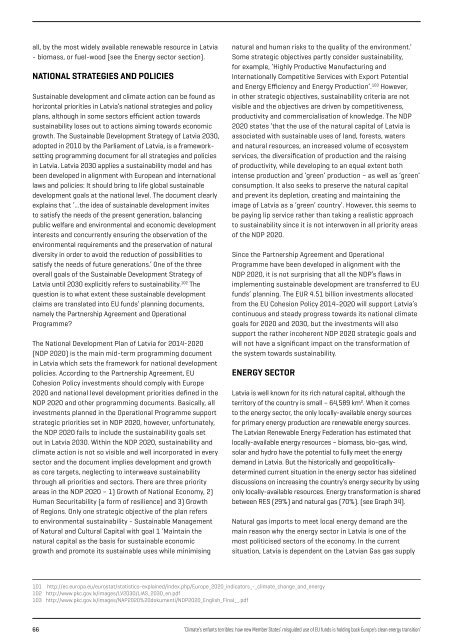ENFANTS TERRIBLES
enfants-terribles
enfants-terribles
You also want an ePaper? Increase the reach of your titles
YUMPU automatically turns print PDFs into web optimized ePapers that Google loves.
all, by the most widely available renewable resource in Latvia<br />
- biomass, or fuel-wood (see the Energy sector section).<br />
NATIONAL STRATEGIES AND POLICIES<br />
Sustainable development and climate action can be found as<br />
horizontal priorities in Latvia’s national strategies and policy<br />
plans, although in some sectors efficient action towards<br />
sustainability loses out to actions aiming towards economic<br />
growth. The Sustainable Development Strategy of Latvia 2030,<br />
adopted in 2010 by the Parliament of Latvia, is a frameworksetting<br />
programming document for all strategies and policies<br />
in Latvia. Latvia 2030 applies a sustainability model and has<br />
been developed in alignment with European and international<br />
laws and policies: It should bring to life global sustainable<br />
development goals at the national level. The document clearly<br />
explains that ‘...the idea of sustainable development invites<br />
to satisfy the needs of the present generation, balancing<br />
public welfare and environmental and economic development<br />
interests and concurrently ensuring the observation of the<br />
environmental requirements and the preservation of natural<br />
diversity in order to avoid the reduction of possibilities to<br />
satisfy the needs of future generations.’ One of the three<br />
overall goals of the Sustainable Development Strategy of<br />
Latvia until 2030 explicitly refers to sustainability. 102 The<br />
question is to what extent these sustainable development<br />
claims are translated into EU funds’ planning documents,<br />
namely the Partnership Agreement and Operational<br />
Programme?<br />
The National Development Plan of Latvia for 2014-2020<br />
(NDP 2020) is the main mid-term programming document<br />
in Latvia which sets the framework for national development<br />
policies. According to the Partnership Agreement, EU<br />
Cohesion Policy investments should comply with Europe<br />
2020 and national level development priorities defined in the<br />
NDP 2020 and other programming documents. Basically, all<br />
investments planned in the Operational Programme support<br />
strategic priorities set in NDP 2020, however, unfortunately,<br />
the NDP 2020 fails to include the sustainability goals set<br />
out in Latvia 2030. Within the NDP 2020, sustainability and<br />
climate action is not so visible and well incorporated in every<br />
sector and the document implies development and growth<br />
as core targets, neglecting to interweave sustainability<br />
through all priorities and sectors. There are three priority<br />
areas in the NDP 2020 – 1) Growth of National Economy, 2)<br />
Human Securitability (a form of resilience) and 3) Growth<br />
of Regions. Only one strategic objective of the plan refers<br />
to environmental sustainability - Sustainable Management<br />
of Natural and Cultural Capital with goal 1 ‘Maintain the<br />
natural capital as the basis for sustainable economic<br />
growth and promote its sustainable uses while minimising<br />
natural and human risks to the quality of the environment.’<br />
Some strategic objectives partly consider sustainability,<br />
for example, ‘Highly Productive Manufacturing and<br />
Internationally Competitive Services with Export Potential<br />
and Energy Efficiency and Energy Production’. 103 However,<br />
in other strategic objectives, sustainability criteria are not<br />
visible and the objectives are driven by competitiveness,<br />
productivity and commercialisation of knowledge. The NDP<br />
2020 states ‘that the use of the natural capital of Latvia is<br />
associated with sustainable uses of land, forests, waters<br />
and natural resources, an increased volume of ecosystem<br />
services, the diversification of production and the raising<br />
of productivity, while developing to an equal extent both<br />
intense production and ‘green’ production – as well as ‘green’<br />
consumption. It also seeks to preserve the natural capital<br />
and prevent its depletion, creating and maintaining the<br />
image of Latvia as a ‘green’ country’. However, this seems to<br />
be paying lip service rather than taking a realistic approach<br />
to sustainability since it is not interwoven in all priority areas<br />
of the NDP 2020.<br />
Since the Partnership Agreement and Operational<br />
Programme have been developed in alignment with the<br />
NDP 2020, it is not surprising that all the NDP’s flaws in<br />
implementing sustainable development are transferred to EU<br />
funds’ planning. The EUR 4.51 billion investments allocated<br />
from the EU Cohesion Policy 2014-2020 will support Latvia’s<br />
continuous and steady progress towards its national climate<br />
goals for 2020 and 2030, but the investments will also<br />
support the rather incoherent NDP 2020 strategic goals and<br />
will not have a significant impact on the transformation of<br />
the system towards sustainability.<br />
ENERGY SECTOR<br />
Latvia is well known for its rich natural capital, although the<br />
territory of the country is small – 64,589 km 2 . When it comes<br />
to the energy sector, the only locally-available energy sources<br />
for primary energy production are renewable energy sources.<br />
The Latvian Renewable Energy Federation has estimated that<br />
locally-available energy resources – biomass, bio-gas, wind,<br />
solar and hydro have the potential to fully meet the energy<br />
demand in Latvia. But the historically and geopoliticallydetermined<br />
current situation in the energy sector has sidelined<br />
discussions on increasing the country’s energy security by using<br />
only locally-available resources. Energy transformation is shared<br />
between RES (29%) and natural gas (70%). (see Graph 34).<br />
Natural gas imports to meet local energy demand are the<br />
main reason why the energy sector in Latvia is one of the<br />
most politicised sectors of the economy. In the current<br />
situation, Latvia is dependent on the Latvian Gas gas supply<br />
101<br />
102<br />
103<br />
http://ec.europa.eu/eurostat/statistics-explained/index.php/Europe_2020_indicators_-_climate_change_and_energy<br />
http://www.pkc.gov.lv/images/LV2030/LIAS_2030_en.pdf<br />
http://www.pkc.gov.lv/images/NAP2020%20dokumenti/NDP2020_English_Final__.pdf<br />
66<br />
‘Climate’s enfants terribles: how new Member States’ misguided use of EU funds is holding back Europe’s clean energy transition’


